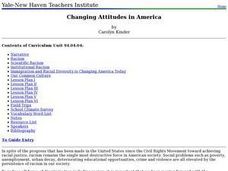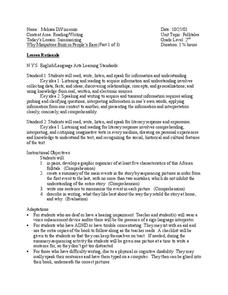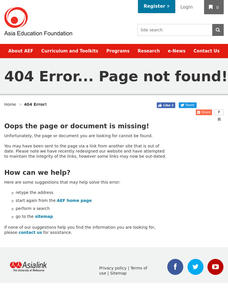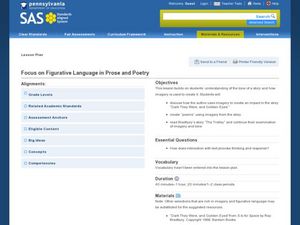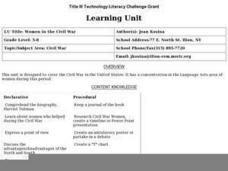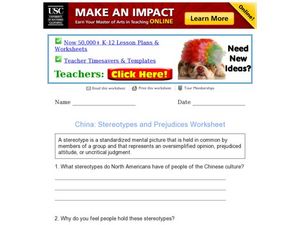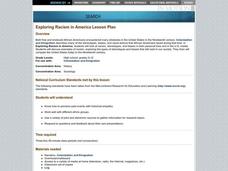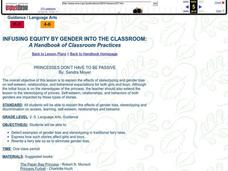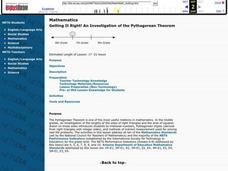Curated OER
Changing Attitudes in America
Students discuss strategies for confronting destructive stereotypes and mythologies, as well as promoting racial understanding in Students.
Curated OER
Why Mosquitoes Buzz in People's Ears
Second graders study folktales and their characteristics. After brainstorming what they know about Africa, 2nd graders read a book about mosquitoes. In groups, students develop a graphic organizer about the characteristics of the...
Curated OER
A Pottery Business In Asia
Students read and discuss some material about Neerja International, a successful business in India, then construct a role play about how the business began. Students role play as people trying to start up their own business and learn...
Curated OER
Changes in Latitudes, Changes in Attitudes
Sixth graders discuss how people, society, and technology change over time through a unit of integrated lessons. In these changes in society lessons, 6th graders discuss the answers to many questions about how changes effect the...
Curated OER
Focus on Figurative Language in Prose and Poetry
Students place emphasis on the use of figurative language when analyzing prose and poetry. In this figurative language lesson, students explore the tone of a story and its imagery. Students read and discuss how the author uses imagery in...
Curated OER
Countering Homophobia: Feelings, Tolerance, Sexuality, Stereotypes
Students explore and discuss name-calling, feelings and myths relating to homosexuality through labeling feelings and participating in a game.
Curated OER
Women in the Civil War
Students study the Civil War era in the US with a concentration on women during this time through literature and biographies. They create a timeline or multimedia presentation as one product of this series of lessons.
Curated OER
China: Stereotypes and Prejudices
In this China worksheet, students read a definition of the word stereotype, then answer 4 questions about stereotypes and prejudice in China.
Curated OER
Call It a Hunch
Give young scholars a chance to practice making inferences after reading the book Through My Eyes by Ruby Bridges. They confirm whether or not their conclusions are true, have a class discussion, and then independently complete an...
Facing History and Ourselves
Laws and the National Community
When it comes to the law, is justice always served? Teach scholars about how law sometimes enables prejudice of entire groups of people with a unit on World War II that includes a warm-up activity, analysis of primary sources,...
Pennsylvania Department of Education
Drawing Conclusions Based on Literary Elements
Students compare versions of Cinderella and draw conclusions based on the story elements identified. In this literacy comprehension and story elements lesson, students read several versions of Cinderella, complete a "Comparing Folklore"...
Curated OER
Zoom Out
Students explore visual perception and how objects change as distance changes. In this distance and vision instructional activity, students practice their scientific inquiry skills. Students practice drawing objects from different points...
Curated OER
Exploring Racism in America
Students compare racism today to racism that existed during the nineteenth century. As a field research project, students individually keep track of examples of racism, biases, and stereotypes illustrated throughout the US media over a...
Curated OER
Refugees' Experiences in Countries of Asylum: "What's in a name"?
Ninth graders examine the term stereotype. In this Current Events lesson, 9th graders analyze posters on racism. Students watch news reports on racism and stereotyping.
Curated OER
Esperanza Rising - Literature Circles and Review (Day 3)
Kids love working with their peers. Get your class into small literature circles and have them complete weekly assignments. Before beginning this week's activity, have each learner write a letter from Esperanza in California to Abuelita...
Curated OER
Five "E" Lesson-Stereotypes
Students discuss the nature of stereotyping and prejudicial behavior and their feelings regarding people with visible disabilities. They view part of documentary Graduating Peter then work in groups to chart people's reactions and...
National Endowment for the Humanities
Not 'Indians,' Many Tribes: Native American Diversity
Students explore what they thought they knew about "Indians." They examine the Hopi, Abeneki and Kwatiutl tribes in a game-like activity using archival documents.
Curated OER
The Big, Bad Wolf
Seventh graders analyze the stereotyping of wolves in children's literature. They compare stereotypes and facts about wolves. They rewrite a fairy tale from the wolf's point of view.
Curated OER
Comic Book Characters
Explore gender stereotypes by analyzing how male and female characters are depicted in comic books. Using the provided Comic Book Analysis sheet, students record the attributes of male and female comic book characters. Then the whole...
Curated OER
Princesses Don't Have to be Passive
Students rewrite a fairy tales to eliminate any gender bias that occurs in the original fairy tale. In this gender bias lesson plan, students also discuss how gender bias effects self esteem, relationships, and behaviors.
Curated OER
Math News
Young writers design and publish a newsletter with articles that demonstrate knowledge of mathematical concepts. They explain mathematical procedures and basic operations in a news article format. Next, they compile several articles to...
Curated OER
Getting It Right! An Investigation of the Pythagorean Theorem
Learners construct a variety of right triangles using a right-angled set square, cutting corners from pieces of paper or cardboard, and using dynamic geometry software. They measure the sides of these various right triangles and record...
Annenberg Foundation
Exploring Borderlands
What motivated Europeans to explore the New World, and what effects did their exploration have on Native American populations? The second installment of a 16-part American Passages series prompts pupils to watch a video and read several...
Curated OER
The Gingerbread Person
Students discuss gender bias and stereotyping. In this social science lesson plan, students read the book "The Gingerbread Boy" and discuss why it is a boy. Students then write their own story changing it to a gingerbread girl and a...
